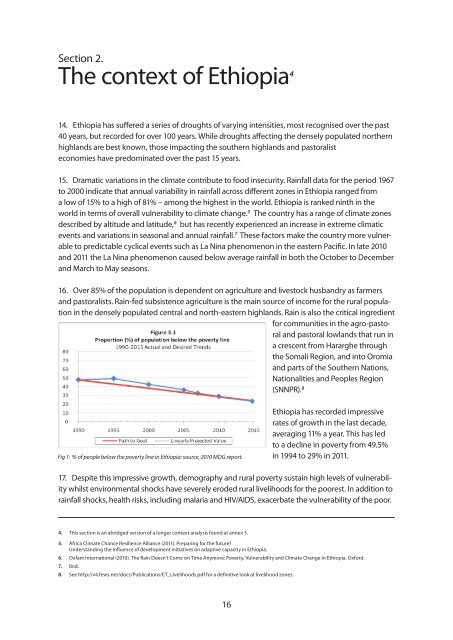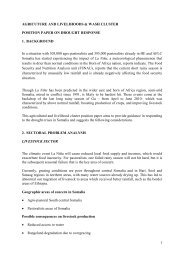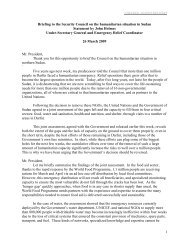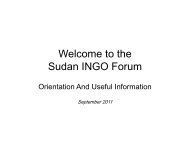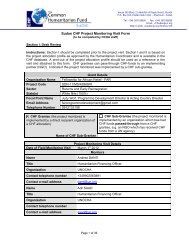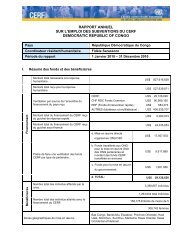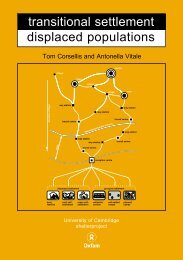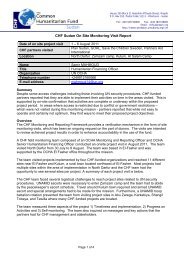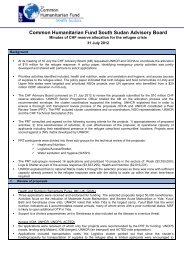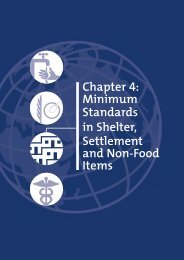Ethiopia - OCHANet
Ethiopia - OCHANet
Ethiopia - OCHANet
You also want an ePaper? Increase the reach of your titles
YUMPU automatically turns print PDFs into web optimized ePapers that Google loves.
Section 2.<br />
The context of <strong>Ethiopia</strong> 4<br />
14. <strong>Ethiopia</strong> has suffered a series of droughts of varying intensities, most recognised over the past<br />
40 years, but recorded for over 100 years. While droughts affecting the densely populated northern<br />
highlands are best known, those impacting the southern highlands and pastoralist<br />
economies have predominated over the past 15 years.<br />
15. Dramatic variations in the climate contribute to food insecurity. Rainfall data for the period 1967<br />
to 2000 indicate that annual variability in rainfall across different zones in <strong>Ethiopia</strong> ranged from<br />
a low of 15% to a high of 81% – among the highest in the world. <strong>Ethiopia</strong> is ranked ninth in the<br />
world in terms of overall vulnerability to climate change. 5 The country has a range of climate zones<br />
described by altitude and latitude, 6 but has recently experienced an increase in extreme climatic<br />
events and variations in seasonal and annual rainfall. 7 These factors make the country more vulnerable<br />
to predictable cyclical events such as La Nina phenomenon in the eastern Pacific. In late 2010<br />
and 2011 the La Nina phenomenon caused below average rainfall in both the October to December<br />
and March to May seasons.<br />
16. Over 85% of the population is dependent on agriculture and livestock husbandry as farmers<br />
and pastoralists. Rain-fed subsistence agriculture is the main source of income for the rural population<br />
in the densely populated central and north-eastern highlands. Rain is also the critical ingredient<br />
for communities in the agro-pastoral<br />
and pastoral lowlands that run in<br />
a crescent from Hararghe through<br />
the Somali Region, and into Oromia<br />
and parts of the Southern Nations,<br />
Nationalities and Peoples Region<br />
(SNNPR). 8<br />
Fig 1: % of people below the poverty line in <strong>Ethiopia</strong>: source, 2010 MDG report.<br />
<strong>Ethiopia</strong> has recorded impressive<br />
rates of growth in the last decade,<br />
averaging 11% a year. This has led<br />
to a decline in poverty from 49.5%<br />
in 1994 to 29% in 2011.<br />
17. Despite this impressive growth, demography and rural poverty sustain high levels of vulnerability<br />
whilst environmental shocks have severely eroded rural livelihoods for the poorest. In addition to<br />
rainfall shocks, health risks, including malaria and HIV/AIDS, exacerbate the vulnerability of the poor.<br />
4. This section is an abridged version of a longer context analysis found at annex 3.<br />
5. Africa Climate Chance Resilience Alliance (2011). Preparing for the future?<br />
Understanding the influence of development initiatives on adaptive capacity in <strong>Ethiopia</strong>.<br />
6. Oxfam International (2010). The Rain Doesn’t Come on Time Anymore: Poverty, Vulnerability and Climate Change in <strong>Ethiopia</strong>. Oxford.<br />
7. Ibid.<br />
8. See http://v4.fews.net/docs/Publications/ET_Livelihoods.pdf for a definitive look at livelihood zones.<br />
16


